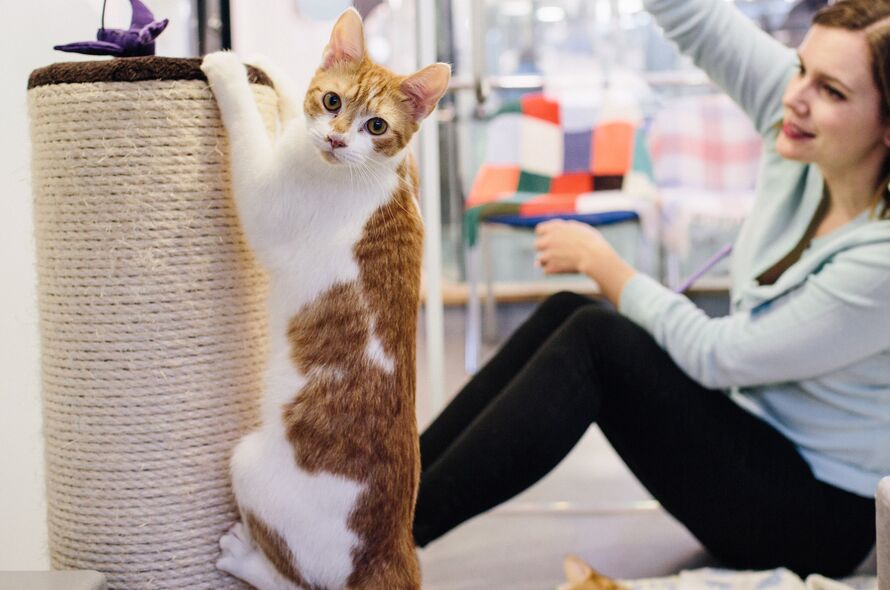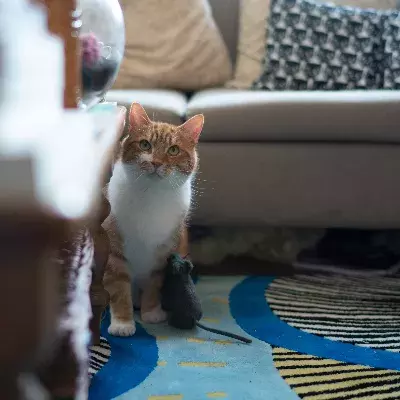Scratching is a perfectly natural behaviour for a cat, and while most cats who have outdoor access will scratch on fence posts and trees, many still like to do some scratching indoors, on the carpet or furniture.

Why Do Cats Scratch Furniture?
Cats scratch in order to loosen and remove the outer part of the claw (called the husk) revealing the sharp surface underneath.
Scratching also exercises the muscles in your cat’s front legs and spine to help keep them fit. The surfaces they choose to scratch on are usually rigid so that they don’t move around when the cat pulls while scratching.
Cats can start to scratch frantically on the carpet when they play and even use scratching as a means of getting their owner’s attention.
If your cat is scratching excessively and you have a multi-cat household, live in a densely cat-populated area, or have recently had building work done (or other similar things going on around the home that might unsettle your cat), the scratching may be anxiety-related.
What Can I Do To Stop My Cat From Scratching My Furniture And Carpets?
Providing your cat with alternative surfaces to scratch is the first step to stopping your cat scratching the furniture or carpets. A general rule is that cats like to scratch on rigid surfaces that resist the pull of their claws, and they like their bodies to be stretched as high or as long as possible to get the full benefit from the exercise. It’s very important not to punish your cat for scratching the furniture. Scratching is a perfectly natural, normal behaviour for a cat so they are not doing something wrong, they simply have no understanding of where it is acceptable or unacceptable to scratch.
Alternative scratching surfaces such as cat scratching boards and posts are readily available in all pet shops and online pet stores. They tend to be made of wood or heavy-duty cardboard and covered in a material such as sisal string (wrapped round posts) or wood bark.
You can also buy multi-level pieces of cat furniture which allow your cat to climb, scratch, perch and even sleep on raised beds that form part of the structure.
If space is an issue, then flat panels with a rough surface can be fixed to walls. There are versions available to buy, or you can make something yourself using sisal, seagrass or coir matting.
Scratching boards which are horizontal as opposed to vertical are also available, usually made from compressed layers of corrugated cardboard. Some are quite flimsy but larger sturdier models are big enough for your cat to stand on and scratch at the same time, so they don’t move around.
Once a cat scratches on a surface, the pheromone scent and the marks they leave will encourage more scratching in the same spot so it’s best to try and provide suitable scratching surfaces as soon as possible.
How Do I Choose The Best Scratching Post For My Cat?
If your cat is scratching on a particular surface or object repeatedly it is important to understand why they are scratching in this area in order to provide a suitable and more appropriate alternative for them to use.
For example, where are they scratching? Some cats like to scratch immediately after they have been asleep, or in ‘strategically significant’ areas such as doorways or routes to their favourite places, such as staircases.
What height is the object that your cat is scratching? Is it a vertical surface, such as the arm of a sofa, or horizontal, such as the hall carpet?
What is the texture of the surface being scratched?
All of the answers to these questions will help you decide what an attractive scratching alternative might look like.
If you have more than one cat, it’s a good idea to provide at least one scratching post per cat, placed in different parts of your house.
I’ve Bought A New Scratching Post, How Can I Encourage My Cat To Use It?
If you’ve bought a new scratching post, make sure you are placing the new scratching surface in a location where your cat spends a lot of time or near where they have previously scratched.
Cats are naturally curious creatures, but they don’t like to feel that they are being forced to do something. Your cat may take some time to explore the new object, but they will accept it more readily if they have decided when and how to use it on their own terms.
If you are keen to speed up the process, a simple game involving a rod and string that dangles a toy around the base of the scratching post will encourage their claws to make contact with the surface to let them know that it is there.
You could also try applying Feliway® FELISCRATCH (Ceva) to the scratching post. This synthetic pheromone smells like the scent that is released by the glands between a cat’s pads and will make it smell familiar.
If you have purchased a tall scratching post or multi-platform ‘cat tree’ make sure it is rigid and doesn’t wobble – you might even need to attach the taller models with a bracket to the wall. You could try placing some treats on the different surfaces to encourage them to explore.
What If My Cat Still Won’t Stop Scratching The Carpet Or Furniture?
If you have tried everything to stop your cat scratching the furniture and carpet, and they are ignoring the alternatives you’ve provided, there are some things you can try to safely deter them.
Firstly, clean the damaged area to remove any trace of the pheromone scent that will be encouraging your cat to keep scratching.
There are various commercial scratching deterrents on the market that can be sprayed on the damaged area to prevent further approaches, but they are very strong and the smell is likely to be offensive to humans as well as cats. These sprays need to be reapplied regularly in order to be effective.
You can try applying some low-tack double-sided adhesive tape over the area as this will provide an unpleasant (but not dangerous or harmful) feeling when your cat puts their paws on it ready to scratch. It is essential to ensure that the tape is not too sticky since it could damage both your cat’s paws and the surface you’re attaching it to.
Double-sided adhesive sheets can be purchased from some household cleaning suppliers specifically to deter your cat from scratching, but they do need replacing with new fresh sheets regularly as the adhesive attracts dust and fibres and loses its strength quite quickly.
If wallpaper has been damaged then thin sheets of Perspex® (rigid plastic) can be cut to size and fitted over the damaged area of wallpaper using screws and wall plugs if appropriate. This surface will be unattractive to scratch since it is smooth, and it is also easily cleaned to remove any scent deposits.
What If My Cat’s Scratching Is Anxiety-Related?
Cats can become tense or anxious for many different reasons and the causes are not always easy to identify by owners.
Excessive scratching is rarely the only sign that your cat might be distressed, so you should keep an eye out for other changes in behaviour. The solution to scratching that is territorial lies in identifying the underlying cause and this is usually best achieved by consulting with an expert.
If you are concerned that your cat’s scratching is anxiety-related, you should contact your vet for referral to a behaviour specialist.
Download the advice on this page as a handy advice sheet and to use as a reminder:
